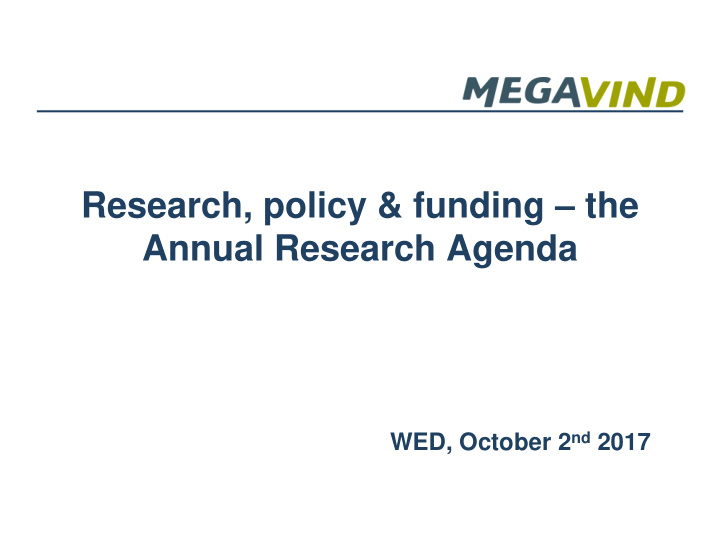



Research, policy & funding – the Annual Research Agenda WED, October 2 nd 2017
UNITED INDUSTRY & RESEARCH INSTITUTIONS ON R&I PRIORITIES IN ORDER TO : • Maintain and strengthen Danish technological leadership • Reduce LCoE • Ensure first class competences • Increase awareness and social acceptance
MEGATRENDS • Maturation, industrialization and globalization; • Subsidy free wind power and technology neutral tenders; • Digitalization; • Energy systems integration.
INDUSTRY PERSPECTIVE • Fierce global competition; • Need for positioning on test facilities and state-of-the- art education; • Understanding the physics of mega turbines and their interaction with wind and waves; • Training, education and recruiting.
RECOMMENDATIONS • Research and Development • Test and demonstration facilities • Education and Training
Public R&D investments is a success for the Danish sector: • By providing the conditions for excellent public research organisations to deliver insights for next generation technologies and educate the human resources to implement it ; • support RD&D activities of our growing base of technology intensive SMEs ; • enabling in de-risking new innovations to mature them to a point where commercial partners can step in and bring a new product or service to the market ; • the opportunity for non-technical issues such as societal acceptance, market mechanisms or policies and regulations to be investigated and evaluated.
RESEARCH AND DEVELOPMENT Research Program for Wind in DK • Improved understanding of the underlying physics of wind energy – up to 330 meter • Development, test and demonstration – digitalization and digital twin • Design, manufacturing, transportation, installation O&M and decommissioning
Definition Of Technology Readiness Levels - NASA • TRL 1 Basic principles observed and reported: Transition from scientific research to applied research. Essential characteristics and behaviors of systems and architectures. Descriptive tools are mathematical formulations or algorithms. • • TRL 2 Technology concept and/or application formulated: Applied research. Theory and scientific principles are focused on specific application area to define the concept. Characteristics of the application are described. Analytical tools are developed for simulation or analysis of the application. • • TRL 3 Analytical and experimental critical function and/or characteristic proof-ofconcept: Proof of concept validation. Active Research and Development (R&D) is initiated with analytical and laboratory studies. Demonstration of technical feasibility using breadboard or brassboard implementations that are exercised with representative data. • • TRL 4 Component/subsystem validation in laboratory environment: Standalone prototyping implementation and test. Integration of technology elements. Experiments with full-scale problems or data sets. • • TRL 5 System/subsystem/component validation in relevant environment: Thorough testing of prototyping in representative environment. Basic technology elements integrated with reasonably realistic supporting elements. Prototyping implementations conform to target environment and interfaces. • • TRL 6 System/subsystem model or prototyping demonstration in a relevant end-to-end environment (ground or space): Prototyping implementations on full-scale realistic problems. Partially integrated with existing systems. Limited documentation available. Engineering feasibility fully demonstrated in actual system application. • • TRL 7 System prototyping demonstration in an operational environment (ground or space): System prototyping demonstration in operational environment. System is at or near scale of the operational system, with most functions available for demonstration and test. Well integrated with collateral and ancillary systems. Limited documentation available. • • TRL 8 Actual system completed and "mission qualified" through test and demonstration in an operational environment (ground or space): End of system development. Fully integrated with operational hardware and software systems. Most user documentation, training documentation, and maintenance documentation completed. All functionality tested in simulated and operational scenarios. Verification and Validation (V&V) completed. • • TRL 9 Actual system "mission proven" through successful mission operations (ground or space): Fully integrated with operational hardware/software systems. Actual system has been thoroughly demonstrated and tested in its operational environment. All documentation completed. Successful operational experience. Sustaining engineering support in place.
Technology readiness level, long/short term and division of work Low TRL Mid-TRL High-TRL Public 80-90% /private Public 65 % / private Public 20% / private 80% 10-20% 35%
TEST AND DEMONSTRATION • Unique Danish financial model for test facilities • Short term needs 90% covered • Need for dialogue about future upscaling
EDUCATION AND TRAINING • Range of new competence in high demand • Universities should increase the use all platforms to educate and attract global talent • Better sector dialogue about competence building required from Ph.d. level to training of technicians
GET YOUR COPY • Physical copy available late October 2017 • Download version on: http://megavind.windpower.org/ Contact the secretariat: eln@windpower.org
Thank you ANY QUESTIONS?
Recommend
More recommend